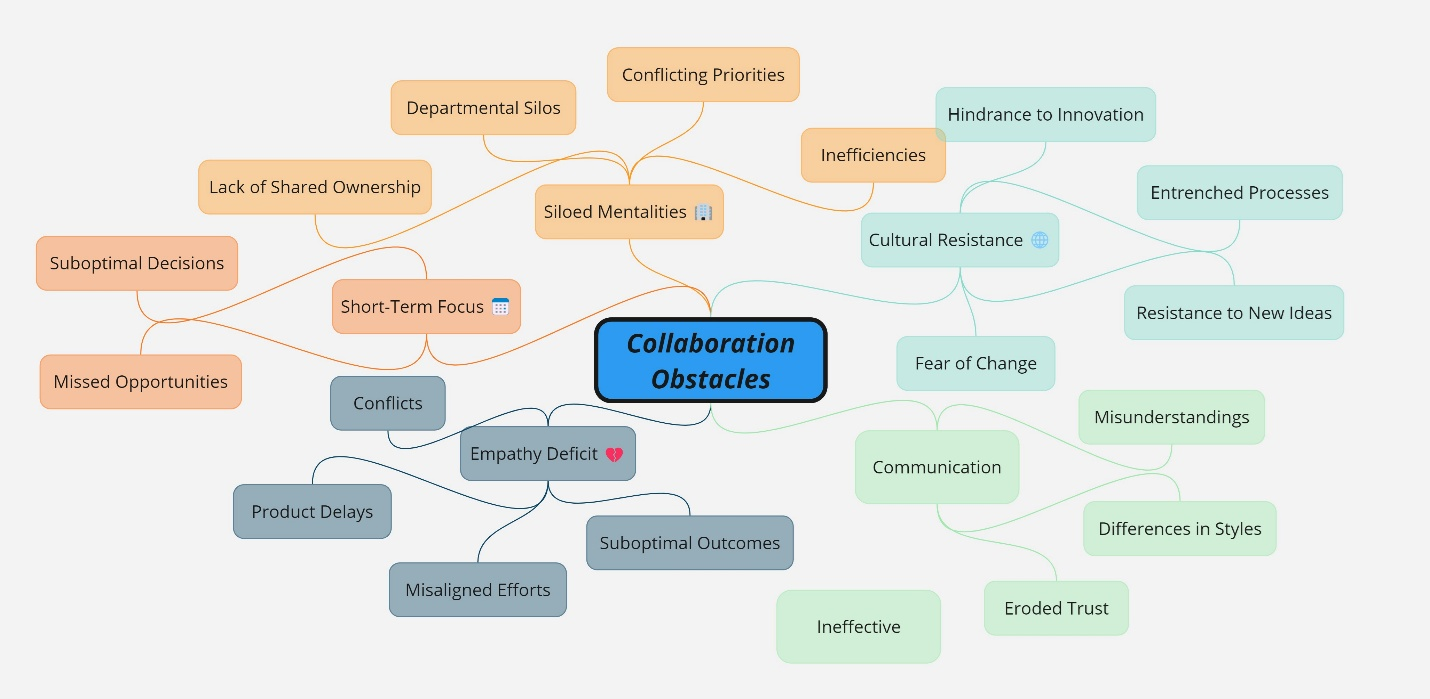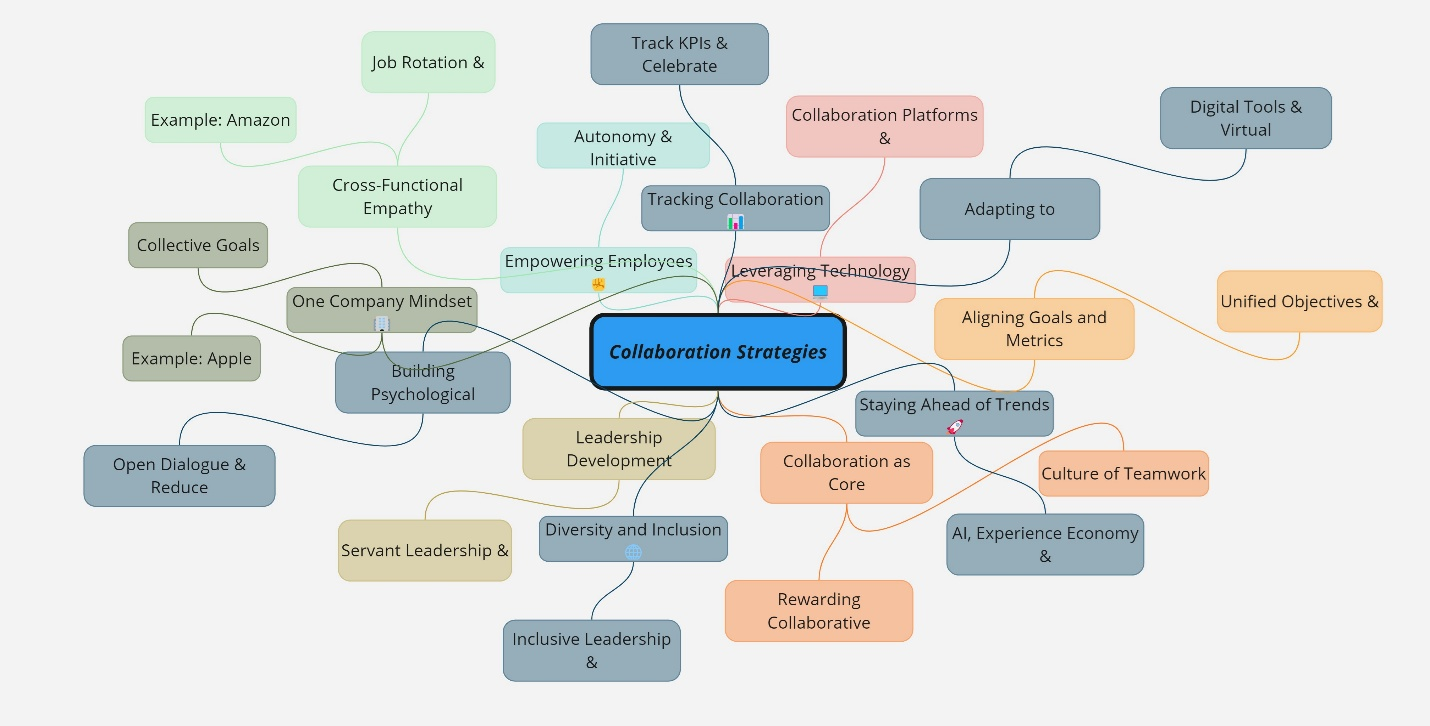
In today’s fast-paced business world, success hinges on agility, innovation, and efficiency. As the adage goes, “Collaboration is the new competitive advantage.” To thrive, organizations must foster cross-functional collaboration by dismantling silos. While this concept is often discussed, truly effective collaboration requires more than just buzzwords—it demands a cultural shift and strategic implementation. My experience leading transformation for the past 10+ years across multiple industry verticals reinforces the critical role of cross-departmental collaboration. It became evident that overcoming entrenched departmental barriers was the key to driving meaningful change.
To succeed, organizations must become “non-destructive innovators,” balancing the need for transformation with the preservation of core values, systems, and employee morale.
While technology is a powerful tool, it’s the human element – a collaborative culture – that truly propels organizations forward. This article explores the strategies and benefits of effective cross-functional teamwork, drawing on insights from industry leaders and my own experiences.
The Collaboration Imperative
Effective cross-departmental collaboration is essential for driving innovation, solving complex problems, and enhancing overall organizational performance. By breaking down silos and fostering a culture of shared ownership, organizations can unlock unprecedented levels of efficiency and customer satisfaction. Here’s how:
- Create a Learning Environment: a culture that prioritizes continuous learning and customer-centric outcomes through development programs and initiatives like hack-a-thons that encouraged collaboration, knowledge sharing, and creative problem-solving, fostering an environment where innovation and adaptability thrive.
- Embrace Outcome Over Activities: new ways of working, a mindset shift that focuses on outcomes rather than activities.
- Shared Purpose – Collaboration vs. Competition: organization-wide benefits rather than single-use or single-department projects, a culture of collaboration over competition, collaborative values, behaviors, and beliefs across the organization.
Research from the Harvard Business Review underscores the challenges faced by cross-functional teams, with 75% struggling to meet key performance metrics. To overcome these hurdles, organizations must prioritize strategic management and cultivate a collaborative mindset.
Benefits of Collaboration
Cross-departmental collaboration is a catalyst for organizational success. By harnessing the power of diverse perspectives, organizations can accelerate innovation and solve complex problems. This synergy leads to optimized operations, enhanced customer experiences, and a culture of creativity. As the adage goes, “Unity is strength,” and cross-functional teams embody this principle. By fostering a culture of shared ownership, organizations can unlock unprecedented levels of efficiency and customer satisfaction. This cross-pollination of ideas leads to….
Innovation Acceleration:
- Example: Apple’s iPhone Development: Apple’s creation of the iPhone involved hardware engineers, software developers, and design teams working closely together. This collaboration, known as “Project Purple,” faced significant challenges, including miscommunications and frustrations common in cross-functional projects, especially under high pressure and tight deadlines. Despite these hurdles, the iPhone’s success is undeniable, contributing to 52% of Apple’s overall revenue. Apple overcame these challenges by fostering a culture of open communication and relentless focus on innovation.
Operational Excellence:
- Example: Amazon’s Integrated Approach: Amazon’s success is partly due to its cross-departmental collaboration between IT, logistics, and customer service teams, providing a seamless customer experience. However, Amazon faced challenges such as misaligned goals and the need for precise management to ensure effective communication and coordination across teams. Amazon addressed these issues by implementing advanced logistics algorithms, centralized data systems, and continuous improvement practices to streamline operations and enhance collaboration.
Strategic Alignment:
- Example: Tesla’s Vertical Integration: Tesla’s approach to manufacturing involves close collaboration between engineering, design, and production departments. This vertical integration allows for rapid iteration and innovation but has faced challenges with team cohesion and communication breakdowns due to its strong hierarchical structure. Tesla overcame these issues by tightly controlling its supply chain and production processes, emphasizing in-house software development, and fostering a culture of rapid problem-solving and innovation.
Tailoring Tesla’s Culture for Global Success:
- Example: Tesla’s Global Culture Adaptation: Tesla has tailored its company culture to succeed in different global markets. In the US, Tesla’s culture aligns with the entrepreneurial spirit and dynamic market. In the UK, Tesla balances innovation with accountability, respecting traditional business norms. In Germany, Tesla emphasizes precision and engineering excellence, aligning with the local business ethos. This cultural adaptation strategy has allowed Tesla to effectively operate in diverse international markets by aligning its core values with local preferences and practices.
Enhanced Problem-Solving:
- Example: Mayo Clinic’s Integrated Care Model: The Mayo Clinic is renowned for its collaborative approach to patient care, where specialists from different departments work together to diagnose and treat complex conditions. This model has led to improved patient outcomes and more efficient healthcare delivery. However, coordinating such diverse expertise requires overcoming substantial logistical and interpersonal challenges. Mayo Clinic addressed these by implementing robust communication systems, interdisciplinary training programs, and a culture that values collaborative care.
Improved Culture of creativity:
Example: Pixar’s Creative Process: Pixar’s success in animation is largely due to its “Braintrust” meetings, where team members from different departments provide honest feedback on projects in development. This collaborative approach ensures their films resonate with audiences worldwide. However, Pixar faced challenges in maintaining open communication and trust among its highly creative but diverse teams. They overcame these by fostering an environment of radical candor and mutual respect, ensuring that every voice was heard and valued.
Obstacles to Effective Collaboration

Effective collaboration is hindered by a myriad of challenges. Siloed mentalities, often characterized as “isolated islands of expertise,” create barriers to information flow and shared ownership. A lack of empathy between departments can further exacerbate these issues, leading to misaligned efforts and suboptimal outcomes. Overcoming these obstacles requires a concerted effort to break down these silos and foster a culture of understanding and cooperation. These obstacles often manifest as:
Siloed Mentalities – A “not in my job description” attitude can create departmental silos, where teams prioritize their own goals over the organization’s overall objectives. This can lead to inefficiencies, duplication of efforts, and a lack of shared ownership. For instance, marketing and sales teams may have conflicting priorities, hindering joint customer initiatives.
Empathy Deficit – A failure to understand and appreciate the perspectives of other departments can result in misaligned efforts, conflicts, and suboptimal outcomes. For example, engineering teams may prioritize technical feasibility over user experience, while design teams may focus on aesthetics without considering functionality. This disconnect can lead to product delays and user dissatisfaction.
Short-Term Focus – An excessive focus on short-term departmental wins can overshadow the organization’s long-term goals. This myopic perspective can lead to suboptimal decisions and missed opportunities for collaboration.
Cultural Resistance – Fear of change, entrenched processes, and a resistance to new ideas can stifle innovation and collaboration. A culture that values the status quo can hinder the adoption of new approaches and technologies. This can also be seen in finance departments prioritizing cost-cutting over revenue generation, hindering investments in innovation.
Communication Breakdown – Ineffective communication, including the use of jargon, unclear messaging, or lack of transparency, can create misunderstandings and erode trust. Differences in communication styles and preferences can also contribute to breakdowns in collaboration.
Addressing these challenges requires a concerted effort to foster a culture of collaboration, open communication, and shared ownership.
Strategies to Foster Collaboration

In an era of rapid change and increasing complexity, cross-departmental collaboration is no longer a luxury but a necessity. To unlock their full potential and thrive in the future, organizations must take deliberate steps to dismantle silos, foster trust, and leverage technology. To achieve this orchestral harmony, organizations must focus on –
Prioritizing Collaboration as a Core Value: Organizations must embed collaboration into their DNA by promoting a culture that values teamwork and shared goals. This can be achieved by recognizing and rewarding collaborative efforts, thus encouraging a more unified approach to achieving business objectives.
Embrace a “One Company” Mindset: Prioritize collective goals over departmental interests. For example, Apple fosters an ownership mentality, aligning all levels with the company’s strategic vision.
Fostering Cross-Functional Empathy: Implement job rotation and cross-training to enhance understanding and collaboration. Amazon’s initiatives expose employees to different business aspects, enhancing empathy and collaboration.
Aligning Goals and Metrics: Establish unified objectives and shared KPIs to ensure everyone is working towards the same goals. A software company, for example, could align development, marketing, and support teams around metrics like customer satisfaction and product adoption rates.
Investing in Leadership Development: Leaders play a crucial role in setting the tone for collaboration. By adopting servant leadership principles, leaders can create an environment where employees feel empowered to contribute. Continuous leadership development programs can help leaders develop the skills needed to foster a collaborative culture.
Empowering Employees: Empowering employees involves giving them the autonomy to make decisions and encouraging them to take initiative. When employees feel valued and trusted, they are more likely to engage in collaborative efforts and contribute innovative ideas.
Leveraging Technology: Technological tools are essential for facilitating effective collaboration. Investing in collaboration platforms, centralized data systems, and advanced analytics can enhance communication, streamline operations, and provide valuable insights that drive decision-making.
Measuring and Tracking Collaboration: Organizations should establish metrics to assess the effectiveness of their collaborative efforts. By tracking key performance indicators (KPIs) related to teamwork, innovation, and customer satisfaction, organizations can identify areas for improvement and celebrate collaborative successes.
Building Psychological Safety: Creating an environment where employees feel safe to express their ideas and take risks is critical for fostering innovation. Psychological safety encourages open dialogue, reduces fear of failure, and promotes a culture of continuous learning and improvement.
Adapting to Remote and Hybrid Work Models: The shift towards remote and hybrid work has changed the way teams collaborate. Organizations must invest in digital tools that facilitate virtual communication and teamwork, ensuring that all employees, regardless of location, can contribute effectively.
Embracing Diversity and Inclusion: Diverse teams bring a wide range of perspectives and ideas, driving creativity and innovation. Inclusive leadership practices ensure that all voices are heard and valued, creating a more dynamic and effective collaborative environment.
Staying Ahead of Future Trends: By keeping abreast of emerging trends such as AI integration, the experience economy, and data-driven decision-making, organizations can position themselves for success in the future of work.
Leveraging Technology to Bridge the Gap
Technology plays a crucial role in bridging the gap between departments and enhancing collaboration:
Key Technological Enablers
- Collaboration Platforms: Tools like Slack, Microsoft Teams, and Asana facilitate real-time communication, project management, and file sharing, fostering a connected and collaborative work environment.
- Centralized Data Systems: Ensuring all departments have access to the same information promotes alignment and reduces miscommunication.
- Advanced Analytics: Implementing data analytics and visualization tools helps identify trends, optimize processes, and inform decision-making.
- Continuous Improvement Platforms: Tools that support continuous improvement practices enable organizations to identify inefficiencies, gather feedback, and implement solutions.
- Virtual and Augmented Reality: These technologies create immersive collaborative experiences, especially for geographically dispersed teams.
- Data privacy is an essential consideration when fostering cross-departmental collaboration. As organizations increasingly rely on data to drive decision-making, it’s crucial to protect sensitive information while enabling data sharing between departments.
By strategically implementing these technologies, organizations can enhance communication, knowledge sharing, and overall collaboration.
Future Trends in Collaboration
The Rise of AI and Automation
- Augmented Collaboration: AI tools can facilitate information sharing, automate routine tasks, and provide insights to enhance human collaboration.
- Virtual Assistants: AI-powered virtual assistants can streamline communication, schedule meetings, and manage tasks, freeing employees to focus on higher-level collaboration.
Remote and Hybrid Work Environments
- Digital-First Collaboration: Organizations will increasingly rely on digital tools and platforms to connect geographically dispersed teams.
- Virtual Collaboration Tools: The demand for advanced video conferencing, virtual whiteboarding, and project management tools will grow.
- Culture Building: Companies will need to invest in fostering a strong company culture and sense of community among remote and hybrid teams.
The Experience Economy
- Customer-Centric Collaboration: Cross-functional teams will collaborate to create exceptional customer experiences across the entire customer journey.
- Data-Driven Collaboration: Organizations will leverage data analytics to gain deeper insights into customer behavior and preferences, informing collaborative decision-making.
The Road Ahead
Driving transformation takes years, not months. While there will be resistance to change, focus on collaboration to drive a mindset shift through servant leadership, with leaders acting as coaches, mentors, and developers, removing blocks, providing guidance, and setting goals and context. Creating psychological safety and empowering the workforce is truly essential to driving business value, growth, customer experience, and innovation.
In an era of rapid change and increasing complexity, cross-departmental collaboration is no longer a luxury but a necessity. By dismantling silos, fostering trust, and leveraging technology, organizations can unlock their full potential, drive innovation, and enhance customer satisfaction. While industry leaders have shown the way, the journey to a truly collaborative culture requires sustained effort and adaptation.
To embark on this collaborative journey, organizations must prioritize collaboration as a core value, invest in leadership development, empower employees, leverage technology, and measure progress. Creating a collaborative culture is like building a bridge between departments: it requires strong foundations, continuous maintenance, and a shared vision. By doing so, they can create a culture where innovation thrives, employees are engaged, and customers benefit from improved products and services.
Looking ahead, successful organizations will not only embrace collaboration but also anticipate its evolution in response to emerging trends like remote work, artificial intelligence, and data privacy. By proactively addressing these challenges and opportunities, businesses can position themselves as leaders in the collaborative economy.
Are you ready to transform your organization? The collaborative revolution starts now.
